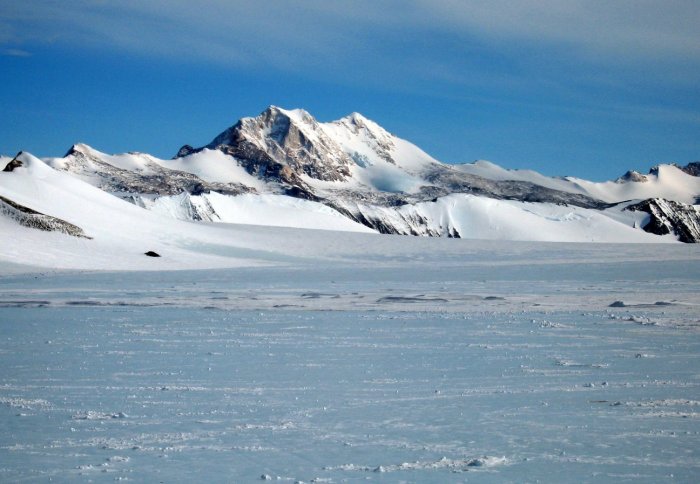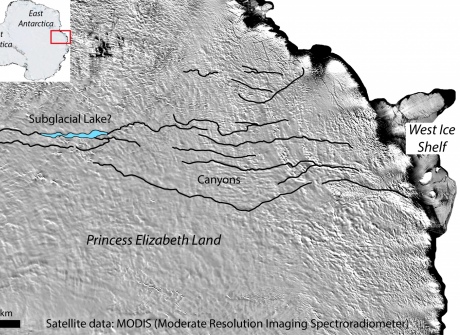

The world's largest canyon may lie beneath the Antarctic ice sheet, according to an analysis of new satellite data.
The previously unknown canyon is thought to be over 1,000 kilometres long and in places as much as a kilometre deep, which would make it comparable in depth to the Grand Canyon in United States, but many times longer.
tantalising prospect
Scientists are hoping to confirm the discovery by taking direct measurements of the canyon through the icy surface of Antarctica. The initial findings are published this month in the journal Geology, by researchers from Durham and Newcastle Universities, Imperial College London, and international collaborators.
Our international collaboration is pushing back the frontiers of discovery on Antarctica like nowhere else on Earth.
– Professor Martin Siegert
Professor Martin Siegert, from the Grantham Institute at Imperial College London, who co-authored the research, said: "Discovering a gigantic new chasm that dwarfs the Grand Canyon is a tantalising prospect.
"Geoscientists in Antarctica are carrying out experiments to confirm what we think we are seeing from the initial data, and we hope to announce our findings at a meeting of the ICECAP2 collaboration, at Imperial, later in 2016."
The canyon system is believed to be made up of a chain of winding and linear features buried under several kilometres of ice in one of the last unexplored regions of the Earth’s land surface: Princess Elizabeth Land (PEL) in East Antarctica.
Very few measurements of the ice thickness have been carried out in this particular area of the Antarctic, which has led to scientists dubbing it one of Antarctica’s two ‘Poles of Ignorance’.
Ancient landscape?
The researchers believe that the landscape beneath the ice sheet has probably been carved out by water. They say it is either so ancient that it existed before the Antarctic ice sheet covered the area, or it was created by water flowing and eroding the rocks beneath the ice.
Although not visible to the naked eye, the new subglacial landscape was identified through the surface of the ice sheet.

Faint traces of the canyons were observed in satellite images, and small sections of the canyons were then found using radio-echo sounding data, whereby radio waves are sent through the ice to map the shape of the rock beneath it.
Further to these findings, the canyons may turn out to be connected to a previously undiscovered subglacial lake. The data suggests the lake could cover up to 1,250 square kilometres, which is more than 80 times as big as Windermere in the English Lake District.
Hiding under the ice
An airborne survey taking measurements over the whole buried landscape is now underway, aiming to confirm the existence and size of the canyon and lake system, with results due later in 2016.
Lead researcher, Dr Stewart Jamieson, from Durham University, said: "Our analysis provides the first evidence that a huge canyon and a possible lake are present beneath the ice in Princess Elizabeth Land. It’s astonishing to think that such large features could have avoided detection for so long.
“This is a region of the Earth that is bigger than the UK and yet we still know little about what lies beneath the ice. In fact, the bed of Antarctica is less well known than the surface of Mars. If we can gain better knowledge of the buried landscape we will be better equipped to understand how the ice sheet responds to changes in climate.”
Co-author, Dr Neil Ross, from Newcastle University, said: “Antarctic scientists have long recognised that because the way ice flows, the landscape beneath the ice sheet was subtly reflected in the topography of the ice sheet surface. Despite this, these vast deep canyons and potential large lake had been overlooked entirely."
INternational discoveries
"Our identification of this landscape has only been possible through the recent acquisition, compilation and open availability of satellite data by many different organisations (e.g. NASA, ESA and the US National Snow and Ice Data Center), to whom we are very grateful, and because of some serendipitous reconnaissance radio-echo sounding data acquired over the canyons by the ICECAP project during past Antarctic field seasons,” Dr Ross said.
Imperial's Professor Martin Siegert, added: "Our international collaboration of US, UK, Indian, Australian and Chinese scientists are pushing back the frontiers of discovery on Antarctica like nowhere else on Earth. But the stability of this understudied continent is threatened by global warming, so all the countries of the world now must rapidly reduce their greenhouse gas emissions and limit the damaging effects of climate change."
The research team was made up of scientists from Newcastle University, Imperial College London and Durham University in the UK, University of Texas at Austin, USA, University of Western Australia, Australian Antarctic Division, University of Tasmania in Australia, and the Polar Research Institute of China.
-
“An extensive subglacial lake and canyon system in Princess Elizabeth Land, East Antarctica”, Jamieson et al, published in Geology, doi: 10.1130/G37220.1
Supporters

Article text (excluding photos or graphics) available under an Attribution-NonCommercial-ShareAlike Creative Commons license.
Photos and graphics subject to third party copyright used with permission or © Imperial College London.
Reporter
Simon Levey
The Grantham Institute for Climate Change

Contact details
Tel: +44 (0)20 7594 5650
Email: s.levey@imperial.ac.uk
Show all stories by this author



Leave a comment
Your comment may be published, displaying your name as you provide it, unless you request otherwise. Your contact details will never be published.